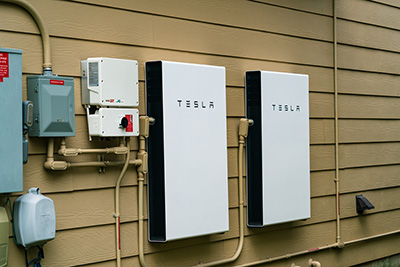Should I Add a Battery to My Solar Energy System?
Last updated October 2023
An increasingly popular add-on is to install batteries that store surplus electricity. Currently, 15 to 20 percent of installations now include some type of storage option, according to Vikram Aggarwal, CEO of EnergySage.com.
Batteries are quite expensive: They’ll add $10,000 to $20,000 to the cost of your project, depending on needed capacity. Unless you plan to live completely disconnected from the grid, you don’t really need batteries; at night, you can power all your stuff the same way you do now. And if you install panels that provide 100 percent of your home’s electricity needs, you overall will produce enough energy from renewables to replace what you used from the oft-polluting grid.
 But the problem is that our dinosaur grid doesn’t always work. Ironically, if you’ve bought a solar energy system to escape electricity generated from fossil fuels, when the lights go out in your neighborhood so go down standard solar systems to prevent them from sending power into the grid and electrocuting workers repairing the lines.
But the problem is that our dinosaur grid doesn’t always work. Ironically, if you’ve bought a solar energy system to escape electricity generated from fossil fuels, when the lights go out in your neighborhood so go down standard solar systems to prevent them from sending power into the grid and electrocuting workers repairing the lines.
Batteries can eliminate the effects of outages by using circuitry that temporarily disconnects their systems from out-of-service power lines, using stored electricity to keep the juice flowing in your home. Even if there’s no outage, having batteries means you can power your stuff at night, rather than tapping into the electricity produced by the fossil-fuel-burning grid.
“Is it practical? Will the battery pay for itself?” asked Lance Wheeler, staff scientist at the U.S. Department of Energy National Renewable Energy Laboratory.
We don’t think batteries are worth the extra expense for most homeowners. Although a pain, power outages are relatively rare and typically short.
For example, according to the U.S. Energy Information Administration, each year the average Delmarva Power and PSE&G customer experiences only one non-momentary outage and loses less than two hours of power. The average PECO Energy customer has only one outage and loses three and a half hours.
While inconvenient, most homeowners won’t consider these outages worth a $10,000-to-$20,000 solution. Unless you live in an area that’s highly prone to more frequent or longer interruptions, depend on electronic medical equipment, or really want to minimize the juice you pull from the grid, batteries seem to us a wasteful purchase.
Also keep in mind that you’ll have to spend more to keep more household systems running for a longer time. Overall, battery capacity is limited, and they’re not designed to power your entire home for days or keep energy hogs like air conditioners running for long. Instead, battery systems are set up to focus on providing juice for your most critical needs: lighting, refrigerator, medical equipment, a small room air conditioner or the blower for a non-electric heating system, and internet. The goal is to get you through a nighttime outage until the sun re-energizes your solar system and recharges your batteries—if grid electricity has not been restored by then. Aggarwal said most homeowners install 7kWh to 17kWh of capacity.
If you’re worried about outages, a cheaper, easier, and more powerful alternative for backup power is a whole-house standby generator. These 5,000- to 20,000-watt units run on diesel or natural gas, and can automatically kick in and power your entire energy lifestyle for as long as it takes. They cost $4,000 to $12,000 with installation by an electrician. The big drawback, however, is noise, which is especially annoying overnight. Check Consumer Reports for ratings of several models; click here for our ratings of local electricians.

